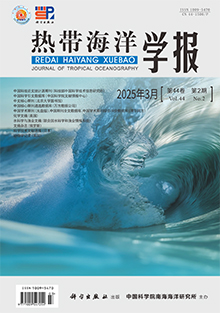|
|
Comparative study of dissolved inorganic carbon systems of surface waters in various oceanic functional areas of Daya Bay
HAN Tingting, QI Zhanhui, WU Fengxia, LIAO Xiuli, MA Shengwei, FU Guiquan, HUANG Honghui
Journal of Tropical Oceanography
2016, 35 (2):
57-65.
DOI: 10.11978/2015059
In four different seasons during March-December 2014, four oceanic function areas in Daya Bay, including in an artificial reef area, an aquaculture area, a thermal discharge area, and a petrochemical sewage discharge area, as well as the bay mouth area, were selected as the survey areas. Data of surface temperature, salinity, pH, and total alkalinity (TA) were analyzed to show the distribution of dissolved inorganic carbon (DIC) system, and to estimate sea-air CO2 flux (FCO2) and its influential factors. The results showed that the concentrations of surface DIC, HCO3-, CO32-, and pCO2 ranged from 1248.8 to 1841.9 μmol·kg-1 (1624.8±143.1 μmol·kg-1), 1069.2 to 1615.7 μmol·kg-1 (1382.5±126.1 μmol·kg-1), 152.7 to 283.5 μmol·kg-1 (236.2±35.4 μmol·kg-1), 11.4 to 44.9 Pa (21.2±7.4 Pa), respectively. There were no significant differences among the surveyed areas in terms of concentrations of DIC, HCO3-, CO32-, and pCO2 (P > 0.05). FCO2 ranged from -37.3 to 4.5 mmol·(m2·d) -1 [-22.4± 9.8 mmol·(m2·d)-1]. The seasonal variation of FCO2 showed an order of summer > autumn > spring > winter, according to positive or negative data; and this parameter in summer was significantly higher than those in the other seasons (P < 0.05). At the annual scale, FCO2 in each investigated area had a negative value, indicating a sink of atmosphere CO2. The distribution of regional carbon sink was in the order of bay mouth area > artificial reef area > petrochemical sewage discharge area > thermal discharge area > aquaculture area, no significant difference being found among these areas (P > 0.05). Based on partial regression coefficients, salinity was the main influencing factor for FCO2 in the bay mouth area and agriculture area; water temperature was, in the artificial reef area and thermal discharge area; and pH was, in the petrochemical sewage discharge area.
Reference |
Related Articles |
Metrics |
Comments(0)
|
|




